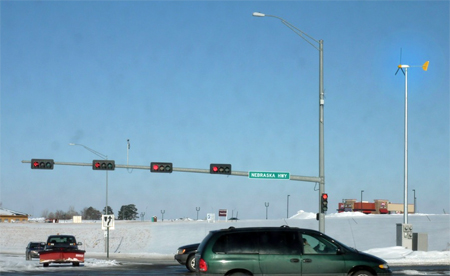Wind-Powered Traffic Lights to Get Tested
A project headed by the University of Nebraska Lincoln Department of Engineering, is researching if traffic lights could pay for themselves by feeding renewable energy into the power grid.
A solar and wind powered traffic light project at the University of Nebraska-Lincoln is nearing its third and final phase, slated to begin in June. The final phase of the project will consist of real-world testing of a smart grid and human testing to determine if wind turbines distract drivers.
 A small wind turbine (upper right) provides electricity for traffic lights in Lincoln. Photograph: Colin Wood, Government Technology |
Research completed so far included the monitoring of a 30-foot Bergey XL 1.0 wind turbine connected to a traffic light at the intersection of 84th Street and Nebraska Highway 2 in Lincoln. The second phase of the project consisted largely of designing and testing the hardware components for the smart grid that will be tested in phase three. Since last summer, the team has also installed a solar panel to be used in conjunction with the wind turbine, with plans for a second solar panel and a new wind sensor in the next few weeks.
The research will also include human test subjects. Pending university approval, the team will run software simulations and field tests to determine if the installation of a wind turbine distracts drivers or slows traffic.
The field test will measure how long it takes drivers to proceed through an intersection that has a wind turbine once the light has turned green. Drivers at nearby intersections that don't have turbines will be the control group. The computer simulation, will monitor other factors, such as the test subject's gaze and heart rate, while "driving" through a simulated intersection like the one on Highway 2.
Future Benefits
There are two benefits of using a system like this: The first benefit is the ability to sell energy back to the power company in an effort to break even on spending, and the second benefit is the ability to use the system's battery packs as a backup system in the event of a power outage or disruption.
The manufacturer considers the lifespan of the system to be 25 years and in locations with more wind and solar resources, or more frequent power outages, the system's value could be higher.
In rural areas this type of system could save cities the cost and trouble of pulling power lines out to isolated traffic signals that need power.
The three-year project is planned to end in April 2013.